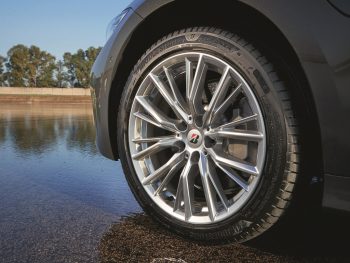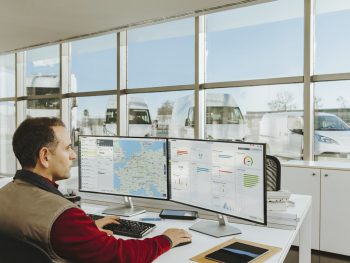Fuel prices seem to have stabilised at the moment, but with costs rising across the board, as well as the everyday pressures of running a fleet, lcv fleet management software could help to ease some of those pressures. VFW has been looking at some recent developments to see how they might help fleet managers.
 It is over 20 years since tyre manufacturer Bridgestone acquired TomTom Telematics from its Dutch parent. The company was probably one of the first tyre manufacturers to realise that the future was going to be digital and that a tyre manufacturer could benefit by acquiring a company that had already established itself in that area. The recent IAA Hanover CV Show gave the company a platform to launch new products. The company describes its Fleetcare Go Plan, as a connected premium tyre and vehicle maintenance solution aimed at small and medium sized fleets. In one package, the company is offering Bridgestone tyres and vehicle maintenance, interfaced with the company’s Webfleet telematics. The tyres will be maintained through Bridgestone’s partner network.
It is over 20 years since tyre manufacturer Bridgestone acquired TomTom Telematics from its Dutch parent. The company was probably one of the first tyre manufacturers to realise that the future was going to be digital and that a tyre manufacturer could benefit by acquiring a company that had already established itself in that area. The recent IAA Hanover CV Show gave the company a platform to launch new products. The company describes its Fleetcare Go Plan, as a connected premium tyre and vehicle maintenance solution aimed at small and medium sized fleets. In one package, the company is offering Bridgestone tyres and vehicle maintenance, interfaced with the company’s Webfleet telematics. The tyres will be maintained through Bridgestone’s partner network.
Fleetcare Go Plan has been developed from Bridgestone’s recently launched Fleetcare package, aimed at large fleets, by giving customers a standardised package compared with the customisable Fleetcare deal. Each customer has access to a dedicated Fleet Portal, providing information on fleet status, services delivered, invoices received and contract progress. The software includes usage-based pricing, paid for with a monthly subscription. For van customers, bills will be re-calculated every six months, even if it differs from the original quotation.
Jan Maarten de Vries, CEO of Bridgestone Mobility Solutions, says: “We believe that by providing actionable and data-driven insights that enable our customers and partners to improve their fleet and mobility performance, we become part of the change we want to see towards a sustainable world.”
VFW spoke to de Vries at the Hanover Show, who told us that establishing Fleetcare is an important milestone for the company. “It’s also the beginning of where we go next, so it’s a foundation, a platform for developing ourselves as a one-stop shop for fleets.” He believes that it will help fleets to address their core requirements, “Being compliant with the regulations, being more efficient in utilising their fleet, but also being more productive, so less waste and being more sustainable and safer on the roads. Those are the key dimensions of the needs that fleets have and that will not change.”

De Vries told VFW that there are two specific areas that he believes fleets need to deal with; fragmentation and a lack of transparency. “On the one side you have fragmentation. That means fleets have to work with a lot of different suppliers to solve different parts of their needs. I foresee that over time, where we build more on this foundation and act more as this “one-stop-shop”, solving the needs around the tyres, solving the needs around fleet management, maintenance and so on. When we act more as a one-stop-shop, we can actually de-fragment the problem of the fleets, not having to work with multiple contracts, multiple suppliers and the integration issues that go with it. Also what comes with this is one digital interface that people in the fleets can use to have a good overview of all the stuff that is relevant to them. This single digital interface, so when they use services from other companies, it goes from this single interface and it acts as a kind of interaction with different types of company.”
De Vries expects there to be an evolution in the way that data is used to provide a better insight into fleet activities.
“I think still today, with the current standard of fleet management, we are not where we will be in the future, because data is often used reactively. So data is extracted from the vehicle. It is processed in the platform and it is delivered to the fleet. Inside on the user interface they can see where their vehicles are, they can see how their driver is doing, what they are doing, they can see whether the vehicle has a problem or not – those things.
“In the future, I foresee that that will evolve into a more predictive and preventive phase, using smart technology and then also the processes around the operation of the vehicle and the fleet.”
STREAMLINING CLAIMS
Streamlining the insurance claims procedure is the aim of the Champion Insurance Group in launching its iWitness Motor Claim Notification Portal. Champion issued its fleet policyholders with a QR code which was printed on Champion branded ‘bump cards’, vehicle dashboard stickers, or drivers’ key rings. The driver can then initiate an insurance claim from the scene of an accident, by scanning the QR code. This will take them to the iWitness portal where they are guided through a simple incident reporting process and encouraged to upload images and videos from the scene directly from their smartphone.
Champion claims that the company can configure the portal, according to policyholder preference, to automatically request statements from witnesses and obtain their version of events while the details are still fresh in their memory. The company says this information can help policyholders defend against contentious claims.
SIMPLIFYING FLEET MANAGEMENT
Fleetclear Connect offers a web-based fleet management software system that provides a simplified way to manage vehicles and drivers. The system combines hardware with GPS tracking, telematics, driver behaviour, advanced data analysis and processing techniques.
“Fuel costs can represent as much as 60% of a fleet’s total operating budget and any reduction can have a significant impact on an organisation’s bottom line,” says Fleetclear technical director Chris Waller. “The Fleetclear Connect system offers a real-time telematics solution that can provide valuable insight into route optimisation, driver behaviour and vehicle performance. Changing behaviour at the driver and vehicle level are crucial when it comes to improving fleet fuel efficiency.
“Our Driver Efficiency Report provides insight into driver behaviour and highlights areas for fuel efficiency improvement, such as excessive idling, harsh braking, and acceleration/deceleration. Drivers are ranked according to their efficiency performance compared to the rest of the fleet and in relation to their best potential. The same tool can be used to identify and recommend the use of electric vehicles in areas that might be suitable. Electrifying a fleet will not only reduce carbon emissions, but will also decrease operational costs, with potential fuel savings of up to 79%.” Fleetclear also provides tools for vehicle routeing, fuel and maintenance reporting.
“Drivers can initiate vehicle insurance claims from the scene of an accident, via a QR code.”

